Weekend Riches From the Berlin Philharmonic
Simon Rattle and the Berlin Philharmonic were happily ensconced in and around Davies Symphony Hall Thursday through Saturday, showering the city with four grand events in just three days.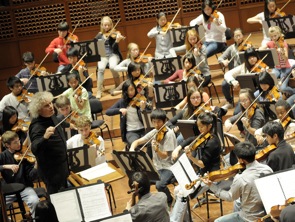
First, there was Rattle's magical rehearsal of Wagner with the San Francisco Conservatory Orchestra (see Jeff Dunn's report), a concert by the Philharmonic at Davies on Friday (see Steven Winn's review), Rattle's rehearsal with the SFS Youth Orchestra on Saturday morning (see item below), and then another orchestral concert at Davies on Saturday evening.
The Saturday evening highlight was an unforgettable performance of Schoenberg's Chamber Symphony No. 1, its reception speaking well of the audience, which gave it an ovation on par with the Philharmonic's "less problematic" Brahms symphonies (which often sounded as if the orchestra tried to be heard all the way back home).
On the cusp of Schoenberg's out-and-out atonality, this is a work of great tonal ambiguity, which requires "work" from the audience even a century after its creation — and the San Francisco listeners made the musicians smile appreciatively when the persistent applause called Rattle out for the fourth curtain call (instead of the usual polite one or two for similar works).
Rattle's master classes with the Conservatory students and the Youth Orchestra were his contributions, without compensation. He is well known for his work with young musicians all the way back to his Birmingham days and, even more intensively, in Berlin.
Enigma of Teen Brilliance
Conductors matter.Those who don't accept that self-evident fact would have benefitted from being in Davies Hall Saturday morning.
There, the ever-surprising, always excellent S.F. Symphony Youth Orchestra had a rehearsal of Elgar's Enigma Variations and produced a world-class performance. "Ysobel," "Troyte", "W.N.," "Nimrod" and other movements marched by with an assured, spirited sound; excitement; and sonic fireworks, in a follow-up to the SFSYO's Nov. 15 concert.
Not at first. At the beginning, what you heard was what you saw: a youth orchestra rehearsing.
And yet, it took a remarkably short time for Simon Rattle — in another voluntary contribution to the local music scene after his S.F. Conservatory master class on Thursday — to lead, inspire, goad, and challenge the Youth Orchestra to rise to the occasion ... and then some.
Unlike his understated manner (for him) at the Conservatory, conducting 20-somethings in Wagner, here Rattle led the kids (ages 12-21) in Elgar with animation and large gestures, at times startling them by shouting instruction over the music.
"Such nice people!," he mocked their sound at one point, demanding "more passion," and commanding: "Shock me!"
Rattle also told them about the role of Elgar "in 200 years of British music," described the characters portrayed in the music ("this guy is in and out, slamming the door behind him").
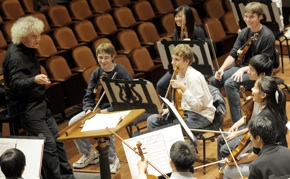 As at the Conservatory, Rattle suggested getting away from "all this accurate stuff," and repeated what he said there: "How can you say something so important playing it so fast?" At one point, he asked for a less bright sound, "make it dark by not moving the bows so fast."
As at the Conservatory, Rattle suggested getting away from "all this accurate stuff," and repeated what he said there: "How can you say something so important playing it so fast?" At one point, he asked for a less bright sound, "make it dark by not moving the bows so fast." At the end, he sincerely (and well deservedly) complimented the youngsters for their work, and said he wished he had 100 tickets to give them for the evening's concert of the Berlin Philharmonic.
He thought for a moment and then suddenly announced that "although the administration and the poor ushers don't know about this," the whole orchestra is invited to the Philharmonic's half-hour warmup rehearsal just before the concert.
How those 100 got in and out of the hall while 2,800 patrons were lining up in the lobby was the staff's problem. The young musicians were getting their reward.
In both venues, Rattle urged his charges "to use your whole body, you cannot sit there like lumps."
Actually, you can. Just a couple of days before, I heard the amazing Kazakh Conservatory Orchestra in Berkeley play Rachmaninov gorgeously, the students sitting "like lumps," without expression on their faces or looking around — especially not at the audience.
This is Soviet-style "academic behavior," and while it's a pity not allowing young musicians to look alive and enjoy themselves, it can also produce discipline and precision. For Wagner, especially conducted by Rattle, that just wouldn't do. (Nor for the fabulous Gustav Mahler Jugendorchester, whose very physical playing of Parsifal under Abbado remains a lasting memory.)
As for the 20-something (or younger) San Francisco students, it occurred to me that if they really, really heard the ecstasy of the love duet or the Liebestod, their own future peak experiences are likely to suffer in comparison. Just another aspect of the dark side of music-making.
David Lomelí: On His Way
... probably to Berlin, and then to many big cities with big opera houses. And that's because the young tenor has a big voice and an even bigger talent.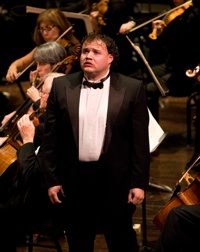
The Mexico City native has already made the rounds in Los Angeles, Oslo, Hamburg, and Munich, but what we heard Sunday was a clear indication of great things to come. Lomelí brought the house down twice at the Herbst Theatre "The Future Is Now" farewell concert for the 2009 Adler Fellows: first, with an ultraromantic, charming "O soave fanciulla," serenading Leah Crocetto, a Mimi equal to this memorable Rodolfo; and then as an intense, dramatic, big-voiced Edgardo, with "Tombe degli avi miei" from Lucia di Lammermoor.
(Berlin came to mind because Philharmoniker intendant and former SFO General Director Pamela Rosenberg was in the audience —
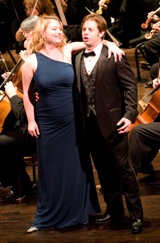 the touring orchestra is on its way from San Francisco to Los Angeles — and she has friends in the German capital, including one Donald Runnicles, of Deutsche Oper Berlin.)
the touring orchestra is on its way from San Francisco to Los Angeles — and she has friends in the German capital, including one Donald Runnicles, of Deutsche Oper Berlin.) And, who knew there would be three impressive tenors among these "future stars" — besides Lomelí, Alek Shrader, a fine lyric tenor with obvious potential beyond his current fach, which served him well tonight as Tamino and Almaviva; and Andrew Bidlack, with a hilarious "Allegro io son," from Donizetti's Rita, and in a terrific Lucrezia Borgia duet with Renée Tatum.
Tatum, an Adler Fellow who has already appeared in several mainstage production this season — making a big impression in small roles in Salome and Il trovatore — wowed the audience tonight with an effortless "O ma lyre immortelle," from Gounod's "Sapho."
Crocetto soloed in the difficult "Selva opaca" from Guglielmo Tell, Daveda Karanas sang "D'amour, l'ardente flamme" from La Damnation de Faust, joining Tamara Wapinsky in a powerful Anna Bolena duet at the end of the concert.
Daniela Mack's Barbiere aria, Austin Kness' from Thomas' Hamlet, and Kenneth Kellogg's from Macbeth and Floyd's Susannah rounded out the program.
Mark Morash, responsible for the slightly offbeat program, conducted the Opera Orchestra, consistently supporting the singers.
The missing Adler class member: Heidi Melton, busy as the Second Maid in the Met's Elektra. Her future is very much now.
Elisabeth Söderström
The great lyric soprano died Friday, at age 82.
A regular at the Metropolitan and in major opera houses around the world, the Swedish singer had a wide range of signature roles, ranging from Marguerite in Faust and Musetta in La bohème to the Composer in Ariadne auf Naxos, Ellen Orford in Peter Grimes, and an unusual triptych of Sophie, Octavian, and the Marschallin in Der Rosenkavalier at various times in her career.
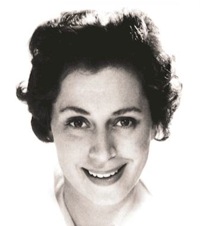
She made her final stage appearance as the countess in Tchaikovsky's The Queen of Spades in 1999.
Max Paley writes:
The two Janáček roles I saw her perform in San Francisco, Kát'a Kabanováa in 1977 and Jenufa in 1980, were two of the greatest performances I've ever experienced.In those roles, she embodied the term "singing actress" in the most complete sense. They were acted with the depth, nuance, physical and facial mobility, and range of expression that one would expect from a great stage actress and they were also magnificently sung. No need to choose between "Kunst" and "Stimme."
The Decca studio recordings of those two operas are very well done, but it takes exceptional audio gear to hear in them the unique glow in the upper
register that characterized her singing in the house.
Shanghai Symphony in Berkeley
A guest review from El Cerrito's Graeme Vanderstoel of the orchestra's Saturday concert in Zellerbach Hall:When the Shanghai Symphony Orchestra, founded as a public band 130 years ago, programs the entire second half of their concert to a composer relatively unknown to an American audience, it must be an interesting piece.Conductor Long Yu started the afternoon concert in Zellerbach Auditorium with the Prelude to Mussorgsky's Khovanshchina. The second piece was the Rachmaninov Second Piano Concerto, with Yuja Wang, whom many, including myself, consider the best young pianist today. It was an exciting performance by Wang and the orchestra, but few in the audience could have imagined what was to follow.
The program note on composer Qigang Chen and his Iris dévoilée (Iris unveiled) was less than two hundred words, a fraction of what was written about the orchestra and soloist. The piece, however, was far from minor.
More can be found on Chen's Web site, where we learn that he was a student of Olivier Messiaen, and that Iris dévoilée was recorded with the Orchestre National de France on Virgin Classics. (Only the pipa and erhu players from the Paris recording performed at Berkeley, and the recording features three sopranos instead of two.) We're also reminded that Chen was appointed as music director of Beijing 2008 Olympic Games Opening Ceremony.
But the program note does tell us that "Chen confided that he never realized how inexhaustible a subject the nature of woman could be to the artist. Iris dévoilée is in nine movements: Ingenious — Chaste — Libertine — Sensitive — Tender — Jealous — Melancholic — Hysterical — Voluptuous. What could be more apt to show this range than a Beijing opera singer, Meng Meng, and Xiaoduo Chen, the Western-style soprano. Their emotions were appropriately accompanied by the symphony orchestra and the three Chinese lady instrumentalists: Jia Li on pipa, Nan Wang playing both the erhu and a larger version, and Xin Sun, on cheng.
Meng sang in pure Beijing opera voice and on hearing Xiaoduo's bel canto, I was struck by their voices: a bel canto can be just as "artificial" as what Westerners normally consider as completely unnatural Chinese opera singing. And the erhu player sitting in front of the concert master, made her instrument sound more natural than a violin.
Now to buy the Virgin CD and relive the excitement. In the foyer, Sonatas & Etudes, Yuja Wang's only CD, was sold (when will we have more?); there was no sign of the Iris recording.
From Here to Shanghai
At the request of Mayor Gavin Newsom, Chanticleer will represent San Francisco at Expo 2010 in Shanghai, returning to the city where the group had a successful China debut earlier this year. General Director Christine Bullin says:
Chanticleer has toured Asia many times — Japan and Taiwan and Hong Kong and Singapore — but we gave the first performances in China May 1-10. It's an extremely intense experience singing there. In Shanghai, for example, the seats sold well and there were banners on the streets.This is intriguing, because there’s not a lot of choral music in China — though there’s now a chorus at the Shanghai Conservatory and choirs are developing across the country. Originally, we imagined a tour of three cities, but it ended up involving five cities and eight performances in 10 days.
San Francisco has an extremely important sister-city relationship with Shanghai. It was also the 30th anniversary of Isaac Stern’s historic visit to the Shanghai Conservatory, which was chronicled in the 1979 film From Mao to Mozart.
Visits of artists and musicians were a big part of the opening of China, and China understands that cultural exchange is an accompaniment to diplomatic communication. The commercial relationship that exists between China and the U.S. is huge, and cultural exchanges paved the way.
Sneaking Up on Wozzeck
Ensemble Parallèle's upcoming production of Wozzeck will have a free "sneak preview" beginning at 6:30 p.m. on Dec. 10 at the San Francisco Conservatory of Music.
The event will feature music from the opera, a Q&A with Stage Director Brian Staufenbiel and video artist Austin Forbord, and a discussion of the work by Artistic Director and Conductor Nicole Paiement.
The Sweet Sorrow of Fixing Up Bach
San Francisco Symphony Choral Director Ragnar Bohlin has a true passion for J.S. Bach, but he finds himself in a situation where he must edit, trim, and even cut one of Bach's great works.
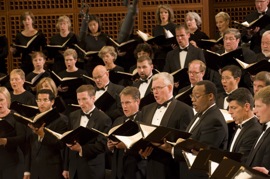 When the Christmas Oratorio is performed in Davies Hall this week, under Bohlin's direction and in his edition, it will not be the "whole thing," not the 1734 work in six parts.
When the Christmas Oratorio is performed in Davies Hall this week, under Bohlin's direction and in his edition, it will not be the "whole thing," not the 1734 work in six parts.
"The whole work is over two and a half hours," Bohlin says. "I have cut it down to about an hour and 45 minutes." And instead of the German text and supertitles the oratorio will be sung in English.
Is that kosher? "It might seem sacrilegious," Bohlin admits, "but remember that Bach wrote this as six separate cantatas, to be performed one by one, in separate services over the Christmas period. Even within the service they were not performed unbroken, but with a one-hour-long sermon in the middle."
There are choral movements, chorales, and arias that serve as reflections and comments to the events in the story. The chorales are incorporated contemporary hymns. "So, what I have done is cut an aria or a choral movement here and there, but tried to be very sensitive to key transitions and character shifts. Thereby, in a sense, a new architecture is built."
It seems Bach himself did many changes, including alteration of the gospel texts. Yes, Bohlin says, Bach saw the six cantatas as a whole, but probably did not intend them — even in those far-away days of long concerts — to be performed back to back in a single sitting. In fact, it is common to perform only three cantatas in a concert.
Bohlin himself has conducted three-and-three in separate concerts in his native Sweden, and this will be his first abbreviated "Christmas Oratorio" as a whole. Veteran SFS Chorus member Noam Cook says:
One thing that stands out about rehearsing the Christmas Oratorio is how much work it is to make the piece sound easy. This is true of any piece. But I think it is particularly true of Bach in general, and especially a major composition like this.Chung-Wai Soong of the Chorus also speaks of the difficulties and rewards of the oratorio:Making all the runs and the small phrases that underscore the meaning of the text come out flowing, buoyant, and natural is really a lot of work. It is difficult to learn and difficult to do. There is a lot of physical work (breath control) and mental work (phrasing and musicality). But when it "clicks" the results are amazing.
Since the Christmas Oratorio is rarely performed in its entirety, there is always the challenge of how to choose among the various pieces. Once that selection is made (as Ragnar has done) the trick for the singers is to form a sense of the whole and use that sense as a kind of navigational aid in making the various pieces we are performing cohere both narratively and musically.
Preparing a major work like this requires negotiating the vocal and technical demands, while making musical and textual sense of it. There can be many options in terms of phrasing and articulation, and our extremely detailed work with Ragnar pays dividends when the chorus is able to come together to realize Ragnar's ideas.A biographical footnote about the choral director: Bohlin is legendary Wagnerian tenor Set Svanholm's grandson; his wife, Tamara Beliaeva Bohlin, is a St. Petersburg-born cellist; and his sister, Ingela, is an operatic soprano currently making her mark all over Europe.From the beautiful melodies and inventive harmonies, to the florid passage work and some "breath-defying" phrases, one has to make it sound easy, natural, and appropriate to the text. The joy in singing Bach is being able to delve deeply into all these aspects, the details and the gestures, the "trees" and "forest," and making glorious music on top of that.
The edited version we are doing still follows the basic narrative structure (from Birth, to the Adoration of the Magi), and it is our job to see how each piece we sing fits as part of the whole, along with the solos and the Evangelist, in service to the story.
